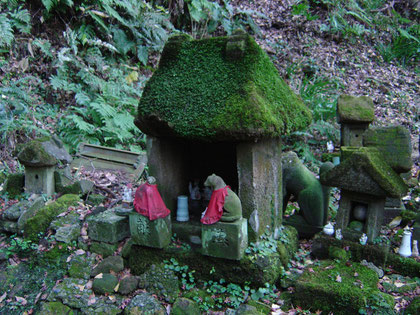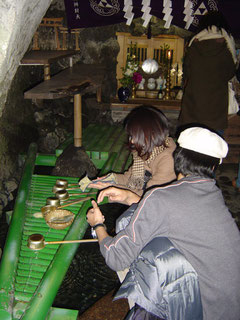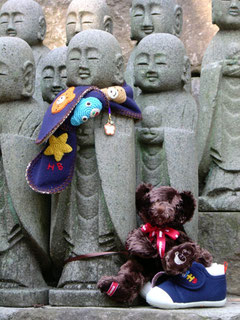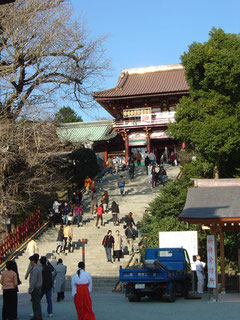Kamakura

Temporary Capital
Though we only met on October 31st, A. was already trying to figure out how we should spend the winter break together by the end of November. She wasn’t able to get time off to join me in Hokkaido, so we instead decided to head to Kamakura, a town about an hour south of Tokyo, shortly before New Year’s.
Kamakurawas the capital of Japan between 1185 and 1333, having been the base of operations for Minamoto Yoritomo, who became shogun in 1192. In his youth, Minamoto’s political enemies killed off everyone else in his family. Rather than kill a boy, they chucked him into a temple in the Izu Peninsula under the presumption that he’d never come back. Note that this is where I live: the place where you throw people when you want them to never come back.
Minamoto based himself in Kamakura because the town was surrounded by easily- defended mountains, and he seems to have spent his spare time filling every last inch of those mountains with shrines and temples.
A. was interested in the more obscure locations, and on our first day we started with a little shrine featuring a pretty, moss-covered stairway that actually had a second stairway built beside it so people wouldn’t wear off the moss. Inside were some impressive statuary, including a formidable warrior standing on some demons that I quite liked, while A. found a statue of the god of healing. She’d been casting me worried glances every time I shimmied up a set of steps like my legs were carved out of hardwood, and she insisted I pay my respects so I could get my knees back in shape. I figured it couldn’t hurt.
Of course, if that counts as worshipping a graven image, I may be going to hell now.
But at least I’d be able to walk down the steps…
We walked through a rather interesting three-story tunnel eroded out of layered sedimentary and igneous rock, and then got pleasantly lost among the residential areas of Kamakura. It seemed that no house was allowed to be boring, and no two were exactly alike. Temples emerged every so often completely unannounced, apparently at random.

The final shrine for the day was Zeni-arai Benten, the most unusual shrine I’ve ever encountered. While most shrines will have a single prominent torii gate, or perhaps a few in succession, this one had two parallel, overlapping rows of plain wooden gates that looked almost as if they’d been dropped in at random. Rather than a discernable central building, the main feature of the shrine was found through a scar-like opening in the rock face to the left, where we encountered a pool of gently circulating water in which it is tradition to wash your money. They even had little wicker baskets and ladles to facilitate the process.
As the story goes, if you wash your money in this pool and spend it while it’s still wet, an equal proportion of money will come back to you. Twenty minutes later, the convenience store clerk didn't even bat an eyelash as A. and I handed her a pair of damp 1000-yen bills. They probably get a hundred of those a day.
Kamakura Daibutsu

We began December 30th with the Kamakura Daibutsu (Great Buddha), completed in 1252 in imitation of the larger Nara Daibutsu. The Daibutsu used to have a sizeable hall around it, but the building was washed away by a tidal wave in 1495, leaving the 850-tonne, 11.4-metre bronze-cast sculpture out in the open for the last 500 years or so. We were even able to climb inside for a whopping—and semi-voluntary—20 yen (23 cents).
Next up was Hasé-dera, on the way to which I spotted a medieval weapons shop and spent a few minutes drooling. Hasé-dera had several levels, all of which presented unique points of interest. First, the obligatory garden at the base was quite pleasant and had several particularly elegant waterfalls. But more interestingly, off to one side there was actually a sequence of caves in which images of what I presumed to be monks had been carved into window-like recesses, looking remarkably like the images of saints you’d find in an old Catholic monastery. These were followed by a low tunnel that ended in a small chamber with two-inch statues lining every available space on the walls and floor. I don’t know what they were for, but A. put some money in a basket and wrote her name on a new one, then placed it by the wall with its friends and relations.

The second level of the temple featured an arrangement of hundreds of pudgy-faced, 18-inch statues being herded by a single life-sized woman with a crook. According to the Lonely Planet, either one or all of these is Jizo, the god of the souls of departed children, and the little figures are given clothes by women who have lost children to abortion or miscarriage. It was a little sad to see the care with which some of them had been dressed.
On the third level was a large temple-like building that housed the 9-m golden statue of the 11-faced Kannon Buddha. Resembling a modern museum on the inside, the building itself was an obvious reconstruction, but the Kannon looked incredible, and somehow seemed to hold more majesty than the larger Daibutsu we’d seen not an hour before.
Riding the train on the way back from Hasé-dera, I spotted a Mountain Equipment Co-Op backpack, and explained to A. that by this brand name alone I could be certain that the wearer was a Canadian. Then I looked closer and realized that I knew the Canadian: it was Frenchy, Socks’ replacement, and her boyfriend up from The Village. Random.

Our final stop was the main shrine of Kamakura, Tsurugaoka Hachiman-gu. The approach from the south followed a wide pathway lined with nearly a kilometre of shrubbery and New Year’s lanterns, and as we entered the shrine we saw people setting up a big light board for the festivities the next day. The shrine itself was quite large, but most impressive was its positioning atop a long, steep staircase, looming mightily over the grounds below.
It was also there that I encountered my first Japanese squirrels, scrawny little critters that make the strangest squawking sound. Japanese people actually put the things into zoos. They should come visit Kingston; it would feel like a wildlife reserve.
Yet Another New Year
A. subsequently went to her parents’ place for New Year’s, and I went back to The Village. St. Nick had been planning to visit friends in Osaka, but he ended up feeling too tired, lazy and indigent to make the trip, so that night we hung out and watched the Two Towers Special Edition DVD while he polished off about ten beers in my apartment.
Then we headed out and entirely failed to find anyone I knew at the shrines around town, let off some crackers, and came back to my place, where St. Nick found my spare futons too comfortable to bring himself to rise until very late the next morning.
Megatokyo
In mid-January, I decided to head to a manga convention in Tokyo in the hopes of meeting Fred Gallagher, a former architect who draws the online comic Megatokyo (www.megatokyo.com). I planned to head up with Neo, another fan, and we met up with some JETs in Mishima the night before so we could get an earlier start on Saturday morning.
Neo sported his new, long, tailor-made-for-$40-in-Vietnam black leather jacket, and looked entirely creepy while using a big black shotgun to play House of the Dead III. I spent the evening telling him there was no spoon. He threatened to put on sunglasses.
We showed up at the local gaijin bar in Numazu on what happened to be salsa night, and were all promptly roped into an introductory lesson by the very insistent instructor, with the lamentable result that I ended up with a partner who seemed to know what she was doing. By the time we tore ourselves free from the bar’s seductive grasp, the parking lot where we’d left our car had been chained shut, so at 4:00 a.m. we headed to a karaoke parlour for an hour of singing and all-you-can-drink while our former designated driver tried valiantly to make up for lost time. We finally stumbled into a Skylark (24-hour "Family Restaurant" chain—a blessing to all those in Japan) as the sun started to come up and napped for about 30 minutes before making the trip to Tokyo.
We met up with A. in Numazu and then her little brother in Tokyo, and by the time we got to the convention we learned that Fred Gallagher’s scheduled events had all finished and the man himself was nowhere to be found. You’d think that in a convention full of geeks, at least one of them would have thought to put the schedule on the Internet.
I did, however, meet up with two friends from Queen’s who’d come all the way down from Aomori, the prefecture north of Akita. I was fortunate to randomly encounter one of them coming out of an elevator. However, in the course of our conversation, I made the mistake of mentioning a Red Dwarf booth I had seen at a convention two years earlier, with the result that a limp-shouldered foreigner felt compelled to step forward and interject.
| Gimpy: |
“I heard you were talking about Red Dwarf!” |
| Me: |
“Um… yes.” |
| Gimpy: |
“I thought maybe you had some new information about the movie.” |
| Me: |
“Um… no. Just… saw a booth… two years ago…” |
| Gimpy: |
“Oh. But it’s a good show, huh.” |
| Me: |
“Um… yes.” |
Then he wouldn’t go away. So much for our reunion conversation.
Sadly, the biggest feature of the convention was probably the Toys R Us in the building’s basement. The convention may have been a waste of ¥3000, but I did get A. a really cool Lego watch.
Note that wearing leather shoes for 48 hours straight will give you something that is not entirely unlike trenchfoot. Ewww...
The Future
As for next year, I am presently hoping to move somewhere that's less than 3 hours’ travel time from A. My boss mentioned that there is an opening in a small town about twenty minutes north of Shizuoka.
Last year when I’d considered moving, my boss had told me that the company would offer up to $1000 to help me move. I remember this clearly because I was staggered by how much they were willing to put up. But when I enquired this year, my boss told me she had no idea where I’d heard such a thing. This displeased me. I further learned that the “location bonus” I’ve been receiving in compensation for losing the low-rent apartment I was supposed to have in The Village will disappear in April, so that’s a big chunk out of my salary every month.
The apartment in the new town is also smaller than my present space and costs $100 more than what I’m paying now.
As for a raise, I’m apparently already at the maximum salary for a teacher, so all they can do is tack on little bonuses, which doesn’t sound like it’ll amount to much. I already get $60 a month as a “seniority bonus,” but I’m told I should start to get a little something for my Japanese ability as well. My travel costs will go down since it won’t cost me $80 to see a movie and $60 to visit A., but for the first time, I’m starting to worry about money.
Then my boss called to say that the BOE in The Town really wants someone for a two-year contract…
I’ve got an interview with another company lined up just in case.
February 2004

